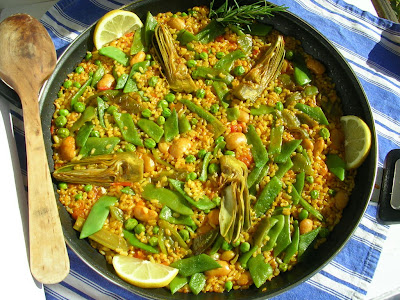 |
| Brown rice and vegetable paella. |
I’ve been trying to cut down on consumption of meat and seafood (for both health and environmental reasons). But I am discovering that it is ever so hard to be vegetarian and still cook Spanish.
The traditional Spanish kitchen uses meat sparingly--a quarter of a stewing hen cooked in a cocido with garbanzos and vegetables feeds a family of six. But ham bone or sausage inevitably turn up even in vegetable, legume and grain dishes, if just for flavor. And, bacalao, salt cod, is a favored addition to vegetable stews for church abstinence days.
So, I have had to do some adapting to turn my favorite recipes into vegetarian fare. Here’s one that has been a great success—vegetarian paella made with brown rice. It’s full of flavor, ever so satisfying. Just right for a (meatless) Sunday lunch. Lunch, because the Valencianos, inventors of paella, say you never, ever eat paella at night! But, that’s your call.
Brown Rice Paella with Vegetables
Flavoring the rice: stock. If you are not a strict vegetarian, you might use a chicken or shellfish broth to cook the rice in. But, I wanted to avoid them. To suggest the flavor of the sea, I used kelp in the water for cooking the rice. I think kombu or wakame would work best, but all I had was nori.
Bring 5 cups of water to a boil with 1 teaspoon salt, 1 bay leaf and a slice of onion. Add 2 sheets of nori or a few strips of kombu. Return to a boil. Remove the pan from the heat and allow to set 5 minutes. Strain the water, discarding the kelp.
 |
| Medium, short-grained rice for paella, white and brown. |
Bring the flavored water to a boil. Add 2 cups of brown rice. Bring to a boil, cover and simmer for 15 minutes. Remove from heat and allow to stand 15 minutes. Drain the rice. Leave it in a colander to dry.
The vegetables. An authentic Valencian paella usually contains big butter beans called garrafón, as well as flat romano green beans, artichoke and peas and the usual green pepper and tomato. Other vegetables that would work well are asparagus, fava beans, lima beans, cauliflower, pumpkin, zucchini.
Trim 8 ounces romano beans and cut into short lengths. Cook in 5 cups boiling salted water until crisp-tender, about 6 minutes. Drain, saving the cooking water. Refresh the beans in cold water and drain them.
Have ready ½ cup fresh or frozen shelled peas, 1 whole artichoke, 1 cup cooked butter beans, 2 cloves chopped garlic, 1 chopped green pepper and 1 cup peeled and chopped tomato.The pan: I use a non-stick paella pan instead of the traditional rolled steel pan. No, you won’t get that (desirable) crunchy soccarat on the bottom of the rice. But neither do you have to worry about the pan rusting. A 14-inch pan fits about right on a stove burner and will serve 4 to 6 persons. No paella pan? Use a large skillet or a flat-bottomed wok.
Creating flavor: the sofrito: The sofrito is the mixture of sautéed ingredients that flavors the rice. Olive oil is the essential starting point of a good sofrito.
Heat 5 tablespoons olive oil in the paella pan. Add the chopped peppers and garlic. Snap off a few outer leaves of the artichoke and cut it into quarters, if small, or eighths if very large. Nip out the fuzzy choke with a knife point. Add the artichoke directly to the oil. (It does not need to be rubbed with lemon.)
Add the chopped tomato and continue frying on a medium heat. Heat the reserved bean liquid.
 |
| Crush saffron and steep in hot water. |
Crush ½ teaspoon saffron in a mortar. Add ¼ cup hot water and let it infuse 10 minutes. Crush 10 peppercorns in the mortar with coarse salt. Add 1 teaspoon sweet pimentón (paprika, not smoked).
Stir the partially cooked rice into the pan. Sauté the rice 2 minutes. Add the saffron water and ground pepper and paprika. Stir in the peas, cooked butter beans and a sprig of rosemary. Add 3 cups of the hot bean liquid. Stir to combine all the ingredients.
Bring the rice to a boil. Cook, uncovered, on a medium heat for 12 minutes. Stir in the reserved cooked green beans. Add 1 cup more of the cooking liquid. Bring again to a boil, then reduce heat to low.
Cook 10 minutes more, without stirring. Rotate the pan over the heat occasionally. Remove from heat. Cover with foil or a cloth and allow to set 10 minutes before serving. If desired, garnish the top of the paella with strips of roasted red peppers and lemon wedges. Serves 4 to 6.
 |
| Vegetarian paella with brown rice. |
This is such a great idea! I have been loving the nutty flavor of the brown rice from Calasparra, but hadn't thought of trying it in paella. Cauliflower, fava beans and garlic shoots are common ingredients in the veggie paellas in Murcia (which often contain bacalao, too). It's great to have the visuals for preparing the saffron.
ReplyDeleteAnsley: It's true that brown rice needs extra cooking time, but then it's every bit as good as white. Lots of paella and rice dishes with bacalao or other seafood--but, then they aren't vegetarian!
ReplyDelete